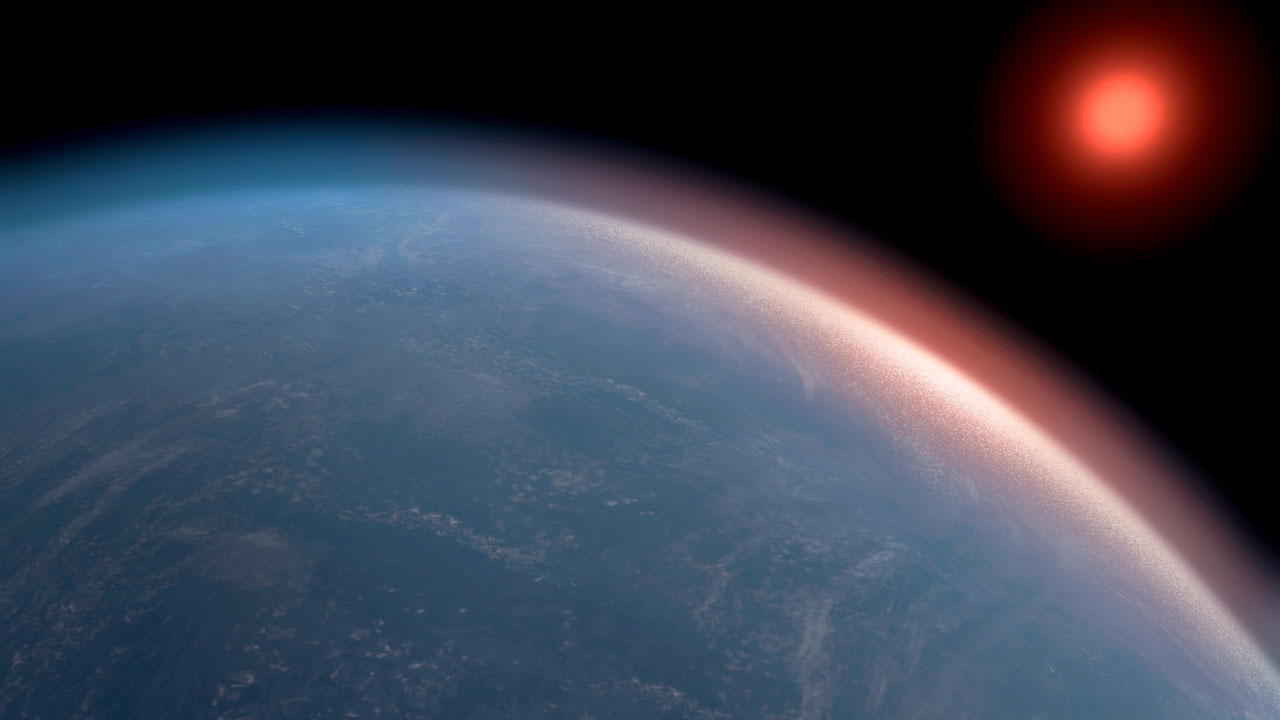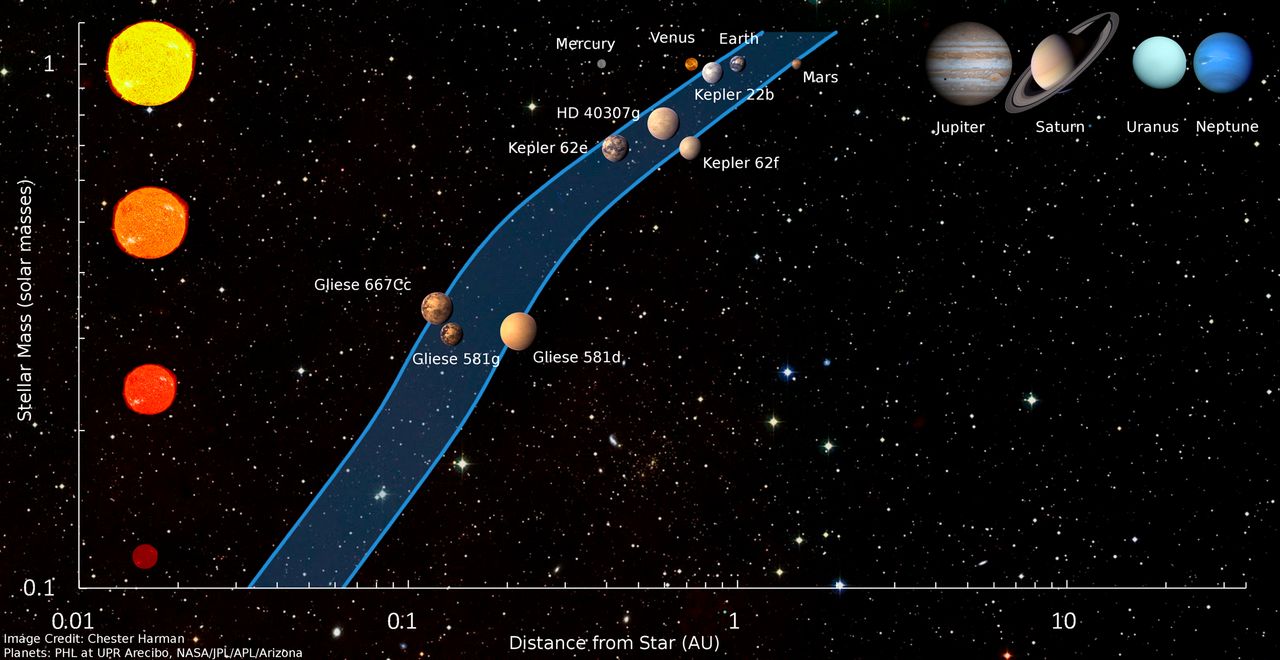The K-dwarf opportunity
K-dwarfs, and more specifically, the late K-dwarfs (K4-K9, with effective temperatures between 3800-4600 K) offer the perfect compromise between technical and physical feasibilities.
Habitability: K- vs M-dwarfs
Although the conditions for habitability on the surface of a planet are still poorly understood, there are different properties that we know might hazard sustainable life as we know it. The first of these conditions is the ability of the planet to retain liquid water on its surface. The range of distances from the star where the incident flux on the planet allows this is called the habitable zone (HZ). In the case of M-dwarfs, given their low luminosity, this region is located at periods closer than 30 days. This, although favourable to the planet detection, has some key downsides on the real habitability of the planet. At first, stellar activity on M-dwarfs is a key actor, with energetic stellar flares increasing the luminosity of the star by a relevant percentage and increasing the coronal emission. Flares can also potentially reach the location of the habitable zone threatening any kind of life on its surface. Big stellar spots may also create relevant variations in the incident flux. Also, being closer to their parent stars planets in the HZ might be tidally locked, always facing the same side to the parent star and thus decreasing the probability for life to be sustained in its surface. By contrast, K-dwarfs have their HZ located at longer periods, where planets can have their rotation and orbital periods decoupled, hence allowing the planet to have day-night cycles. Stellar activity and magnetic flaring is dramatically diminished for stars earlier than M3 and specially in the late K-type domain. Consequently, habitability is not threatened by these effects as much as it is in the HZ planets around M dwarfs. Besides, unlike M-dwarfs, we can derive precise stellar parameters and chemical abundances, relevant to properly characterise the planets and the the star-planet connection.

Planet detection in the habitable zone
The K-dwarf habitable zone ranges between 0.1-0.3 AU for the latest types (corresponding to orbital periods between 17-90 days). This corresponds to radial velocity semi-amplitudes of 2.4 - 4.2 m/s in the case of K9 stars and 1-2 m/s for K4 stars with a 10 Earth masses planet in the habitable zone. Added to this, the imprint of stellar activity and magnetic cycles on the radial velocity of K-dwarfs is smaller than in the case of M-dwarfs. For the late K-dwarf stars, the signals induced by magnetic cycles typically have amplitudes below 3 m/s and typical periods of 7 years. On the other hand, although rotation periods span between 15-45 days, K dwarfs in the colour range 1.0 < B − V < 1.3 have the lowest level of activity jitter (Isaacson & Fisher, 2010), significantly less than 1 m/s, thus becoming the perfect targets to search for habitable planets. With a demonstrated precision of around 1.3 m/s in the long-term (after corrections are applied), CARMENES is one of the few instrument in the Northern hemisphere that can reach such precision and stability over a long period of time. The 1.3 m/s precision allows the detection of planets in the HZ regime of K-dwarfs down to the rocky regime. Indeed, it allows completeness for planets with masses above 10 MEarth around late K-dwarf stars and detection limits down to 3 MEarth (see Figure 1).

The K-dwarf habitable zone desert
The strategy followed by ground-based surveys and space-based missions has missed the HZ of K-dwarfs. This is evident in Figure 2, where only a handful of validated transiting planets (i.e., no mass measurement) and two confirmed planets populate the habitable zone around late K-dwarf stars. The histogram on Figure 2 (right panel) illustrates this desert, with a large number of temperate worlds detected around G-type stars (mainly with RV surveys) and another large sample in the low stellar mass regime. This desert is even drier when we focus on planets with determined masses (red histogram). Stellar population studies, however, do not show a paucity of this type of stars in the solar neighbourhood compared to G- and M-types (e.g., Kroupa et al., 1993). Consequently, the HZ-planet desert is indeed an observational. The reasons for this paucity of planets in the habitable zone are clear: the focus on solar-like stars for similarity with the Solar System and the hunt for planets around M-dwarfs due to detectability reasons. A focused and systematic program exploring the habitable zone of K-dwarfs is thus missing. The M2K project (Apps et al., 2010) in 2010 used a small fraction of the Keck/HIRES instrument to look for planets around MK stellar types, only a handful number of systems were announced. The HARPS GTO program (PI: X. Bonfils) has also followed-up some of K-dwarfs. However, these studies were not focused on the HZ of K-dwarfs and hence the sample and cadence was insufficient to reach the rocky regime in the habitable zone. This is mainly due to the lack of telescope time. A dedicated service program with the flexibility of a moderate number of nights per semester and distributed along a sufficiently large time span is thus required to reach this regime. We propose to take the lead on this niche with the KOBE experiment.



